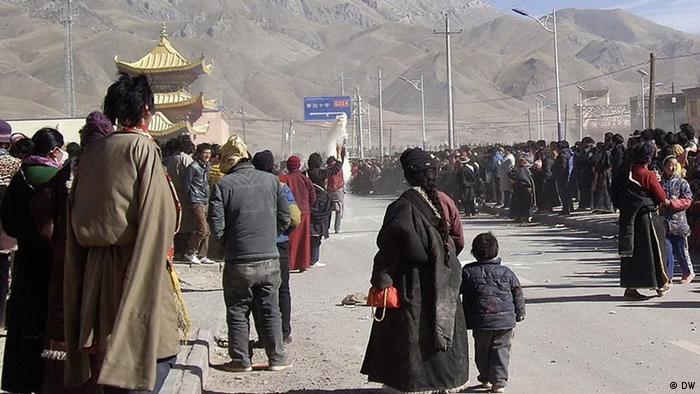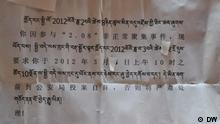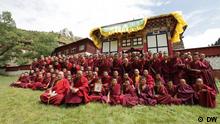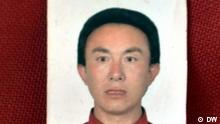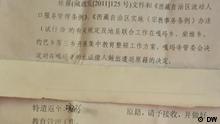
此为该报道的网络截图。
作者:Vijay Kranti
发表: Sify.com
译者:傅春雨 @boattractor_cj
转自:早生代活化石
直到他的自焚成为了世界媒体上火热的轰动, 27 岁的江白益西( Jamphel Yeshi )的故事与现在居住在中国西藏(那个中国领导人称为“社会主义天堂”的地方)内的数百万藏人并无二致。他是大约一万多近年来逃离西藏的藏人青年之一,而他们逃离是为了得到更好的教育或者为被窒息的灵魂找寻喘息之地。
生活在被占领的西藏, 江白益西和他的大多数藏人伙伴一样, 从来没有见过达赖喇嘛,也从来没有生活在中国所称的“达赖集团”的“农奴制”之下,毛的军队早在江白益西出生前三十六 年就已废除之。
也和他的父亲一样,他是成长在日复一日的共产主义教育灌输之下,这套灌输旨在把藏人以及其他55 个中国“少数民族”的儿童转化成“伟大祖国”的“爱国者”。
他也同样的在学校被老师告知:达赖喇嘛是“披着和尚袈裟的豺狼”,是他理应仇恨的“分裂分子”,是他的祖国—— 中国—— 的“最阴险的敌人”。
可是,从他步入青少年并开始意识到他的民族身份之日,也就是他开始感受到压抑窒息之时。在他的家乡,传统上的康藏区(西藏失去自由后被划入邻近的四川省)道孚县,藏人的传统文化正淹没消失于新涌入的汉人(中国的多数民族)定居者的汹涌大潮之中。
江白益西在 2007 年(唯色注:据流亡西藏媒体报道,是2006年)悄悄地越境来到印度。他在印度议会大厦附近的一个由藏人举行的抗议中国、抗议胡锦涛到访的集会上决定自焚,这期间他正在新德里学习计算机课程。
有“拉萨屠夫”之称的胡锦涛尤其让藏人民众反感。在 1989 年的藏人抗议事件中,当时的西藏领导人胡锦涛使用军队、坦克和装甲车严厉镇压。三个月之后,胡的上司采用类似的“拉萨模式”在北京的天安门广场,镇压了中国青年反共产专制的抗议活动。
江白益西是过去一年中在西藏境内外的第 32 位自焚者。星期三,他成为第18位经证实的牺牲者(译注:原文如此。但据藏人诗人、作家唯色统计,他应是 2009 年以来的第 33位自焚藏人,第 23 位牺牲者 )。其余 13 人(唯色注:据我的统计,至江白益西自焚时,有6人在当局手中)的命运只有中国当局才清楚。江白益西去世后,由于显然的原因,新德里政府采取了更加严格的措施,以确保胡锦涛访问得舒适、满意。
译者:傅春雨 @boattractor_cj
转自:早生代活化石
直到他的自焚成为了世界媒体上火热的轰动, 27 岁的江白益西( Jamphel Yeshi )的故事与现在居住在中国西藏(那个中国领导人称为“社会主义天堂”的地方)内的数百万藏人并无二致。他是大约一万多近年来逃离西藏的藏人青年之一,而他们逃离是为了得到更好的教育或者为被窒息的灵魂找寻喘息之地。
生活在被占领的西藏, 江白益西和他的大多数藏人伙伴一样, 从来没有见过达赖喇嘛,也从来没有生活在中国所称的“达赖集团”的“农奴制”之下,毛的军队早在江白益西出生前三十六 年就已废除之。
也和他的父亲一样,他是成长在日复一日的共产主义教育灌输之下,这套灌输旨在把藏人以及其他55 个中国“少数民族”的儿童转化成“伟大祖国”的“爱国者”。
他也同样的在学校被老师告知:达赖喇嘛是“披着和尚袈裟的豺狼”,是他理应仇恨的“分裂分子”,是他的祖国—— 中国—— 的“最阴险的敌人”。
可是,从他步入青少年并开始意识到他的民族身份之日,也就是他开始感受到压抑窒息之时。在他的家乡,传统上的康藏区(西藏失去自由后被划入邻近的四川省)道孚县,藏人的传统文化正淹没消失于新涌入的汉人(中国的多数民族)定居者的汹涌大潮之中。
江白益西在 2007 年(唯色注:据流亡西藏媒体报道,是2006年)悄悄地越境来到印度。他在印度议会大厦附近的一个由藏人举行的抗议中国、抗议胡锦涛到访的集会上决定自焚,这期间他正在新德里学习计算机课程。
有“拉萨屠夫”之称的胡锦涛尤其让藏人民众反感。在 1989 年的藏人抗议事件中,当时的西藏领导人胡锦涛使用军队、坦克和装甲车严厉镇压。三个月之后,胡的上司采用类似的“拉萨模式”在北京的天安门广场,镇压了中国青年反共产专制的抗议活动。
江白益西是过去一年中在西藏境内外的第 32 位自焚者。星期三,他成为第18位经证实的牺牲者(译注:原文如此。但据藏人诗人、作家唯色统计,他应是 2009 年以来的第 33位自焚藏人,第 23 位牺牲者 )。其余 13 人(唯色注:据我的统计,至江白益西自焚时,有6人在当局手中)的命运只有中国当局才清楚。江白益西去世后,由于显然的原因,新德里政府采取了更加严格的措施,以确保胡锦涛访问得舒适、满意。
胡很快就会返回中国,自焚所带来的不愉快气味非常可能被其它源源不断的重大新闻所冲散。但是,江白益西遗留给世界的地狱之火却仍在闪烁跃动,将在信奉民主、推崇文明准则的国际社会经久地飘忽出没,留下一些值得思考的问题。
就让我们来深思一下这些问题吧:
藏人青年(多数是僧尼)的一系列自焚,戳穿了中国一再重复的宣称:西藏境内和谐安定,藏人拥护中国的统治,藏人痛恨达赖喇嘛的“农奴制”。
一个又一个自焚者拼死呼喊“西藏自由”、“让达赖喇嘛返回西藏”,将西藏现状的另一面展现给全球千百万 YOUTUBE 观众:事实与中国政府所称完全相反!
至少有 32 位藏人青年自焚(唯色注:至江白益西自焚时,已是33位藏人自焚;至2012年3月30日,已有36位藏人自焚)却没有一起针对他们的殖民者进行行刺、枪击、爆炸或劫持事件,突出表明了藏人们对他们领袖达赖喇嘛的至深信仰,和对他“不杀生”、甘地主义、非暴力理念的信守。
中国领导人徒劳地试图把达赖喇嘛描述成希特勒或者与美国合作的纳粹,这些事实使得他们成为世人的笑柄。
这些事实无可置疑地证明了西藏境内的抵抗运动在被中国占领 61 年后依然普遍存在,且从没停熄;无可置疑地证明了达赖喇嘛仍然深受爱戴,甚至比他在 1959 年流亡时更受爱戴。
这些事实也证明六十余载共产主义灌输的彻底失败,未能消减藏人的民族意识;而且现在藏人的感受是正在被推向绝望。
32 起自焚的每一起(译注:原文如此)都发生在藏东的康和安多地区,即如今四川、云南、青海、甘肃的一部分—— 这一事实挑战了中国的说法:这些地区不属于西藏,或只有现西藏自治区才是真正的西藏。
这些自焚事件中有许多起,自焚者遭到中国军警和保安人员踢打,甚至旁观的汉人向未死的自焚藏人青年投掷石块,这些行为反映了藏人和在藏区定居的汉人之间的深刻隔阂。
在同一个世界,仅仅一位突尼斯果蔬小贩的自焚就能唤起全世界的声援支持,并掀起席卷 15 个国家的革命,而面对藏人一连串的自焚事件,联合国和各国政府都无动于衷,毫无应对,不禁令人怀疑:难道这个世界的同情心不是基于对人权和民主的信念而激发,而是另有机巧?人们也不禁要大感困惑:难道国际社会尚未进步到一定程度,以至于世界舆论仅取决于一个政府的经济力量而无关于整个世界的道义力量?
至为重要的是,江白益西给国际社会提出了这么一个问题:难道我们已面临一个临界点,全世界无数争取自由和公正的人们即将失去信心,从而怀疑以民主和非暴力诉求解决纷争是否有效?
(致谢译者,我在转载时对个别字词做了修订,也对所报道的事件有所补充。)
Tibetan self immolations: Why isn't the world listening?
By Vijay Kranti
Until he became a burning sensation in the international media, the story of Jamphel Yeshi, 27, was no different from the few million Tibetans who live today in what Chinese leaders call a Socialist Haven or China's Tibet. He was one of those 10,000 odd young Tibetans who could smuggle themselves out of Tibet in recent years in search of better education or to find some breathing space for their suffocated souls.
Like most of his fellow young compatriots in occupied Tibet, Jamphel too had never seen the Dalai Lama nor lived under what China brands the "feudal" rule of the "Dalai clique" that was dethroned by Mao's army 36 years before Jamphel was born.
Like his father, he too was educated and brought up on a daily overdose of Communist indoctrination which hopes to convert Tibetan and children of other 55 "national minorities" of China into "patriotic" citizens of the "great motherland".
He too was told by his class teacher in school that the Dalai Lama was a "wolf in the robes of a monk" and hence deserved their hatred for being a "splitist" and the "worst enemy" of their Chinese motherland.
However, when he entered his teens and started becoming aware of his ethnic identity, he too began feeling suffocated and lost amidst a new flood of Han settlers (the majority community in China) in his traditionally Khampa Tibetan town of Tawu which was assimilated into neighbouring Sichuan province after Tibet lost its freedom.
Jamphel quietly crossed over to India in 2007 and was going through a computer course in Delhi on the day he decided to take the extreme step of immolating himself during an anti-China, anti-Hu Jintao Tibetan rally near the Indian parliament.
Hu is especially despised by Tibetan masses as the "Butcher of Lhasa". As the governor of Tibet, Hu used army tanks and armoured vehicles to effectively crush the Tibetan uprising in Lhasa in 1989. Three months later, it was the same "Lhasa Model" that was used by his seniors in Tiananmen Square in Beijing to crush the Chinese youth's uprising against the Communist system.
Jamphel was the 32nd in a chain of self immolations inside and outside Tibet in past one year. On Wednesday, he became the 18th among the confirmed Tibetan deaths. The fate of the other 13 is known only to Chinese authorities. Following Jamphel's death, the government in New Delhi has, for obvious reasons, decided to further tighten measures to ensure a comfortable stay for Hu Jintao.
Hu will soon return to China and the stink raised by the immolation is most likely to melt away in the flood of other important news. But Jamphel's moving inferno leaves behind some issues which may haunt a world community that expresses faith in democracy and civilised conduct.
Just a few issues to ponder over:
A long chain of self immolations by Tibetan youths, a majority of them monks and nuns, negates the oft repeated Chinese claims that everything is fine inside Tibet. Or that Tibetans love Chinese rule and despise the "feudal" Dalai Lama.
One burning and dying immolator after another shouting for "rangzen" (Tibetan freedom) and return of Dalai Lama to Tibet has exposed another face of Tibetan reality to the millions of YouTube watchers across the world as opposed to what Chinese government claims.
At least 32 cases of self immolation by Tibetan youths and not a single case of stabbing, shooting, bombing or hostage taking against their colonial masters underlines the Tibetan people's deep faith in their leader Dalai Lama and his commitment to 'ahimsa' or Gandhian non-violence.
It also makes a laughing stock of Chinese leadership when they desperately try to paint Dalai Lama as Hitler and a Nazi collaborator of the US.
It establishes beyond doubt that resistance inside Tibet is alive and widespread even 61 years after the Chinese takeover and that the Dalai Lama is, perhaps, more popular that he was on the escape day to exile in 1959.
It also proves that the Communist indoctrination of six decades has failed to cool down the national aspirations of Tibetan masses. And that Tibetan masses today feel pushed to desperation.
Each of the 32 immolations occurred in the erstwhile Tibetan provinces of Kham and Amdo, now parts of Sichuan, Yunnan, Quinghai and Ganzu - this challenges Chinese assertion that these areas are not Tibet or that only Tibet Autonomous Region (TAR) is the "Real Tibet".
In most events of these self immolations, the manner in which the Chinese PSB police and agents kicked the man on flames or the local Han bystanders pelted stones over the dying young Tibetan only reflects the deep divide between the Tibetan and the Chinese settlers in Tibetan areas.
In a world where a single self immolation by a Tunisian vegetable vendor can invoke world support and revolution in 15 countries, the absence of any reaction or measure on the part of the UN and governments towards an unending chain of immolations compel sceptics to think the real triggers of world sympathy lie somewhere else rather than in commitment to human and democratic values.
They might start wondering loudly if the world community has not arrived a stage where world opinion is more influenced by economic power of a single government than the collective moral power of the world at large.
And above all, Jamphel Yeshi has left the world community with a question: have we arrived at a stage where thousands of struggling communities across the world might lose faith in the efficacy of democratic and non-violent expression as a valid tool of conflict resolution?
Until he became a burning sensation in the international media, the story of Jamphel Yeshi, 27, was no different from the few million Tibetans who live today in what Chinese leaders call a Socialist Haven or China's Tibet. He was one of those 10,000 odd young Tibetans who could smuggle themselves out of Tibet in recent years in search of better education or to find some breathing space for their suffocated souls.
Like most of his fellow young compatriots in occupied Tibet, Jamphel too had never seen the Dalai Lama nor lived under what China brands the "feudal" rule of the "Dalai clique" that was dethroned by Mao's army 36 years before Jamphel was born.
Like his father, he too was educated and brought up on a daily overdose of Communist indoctrination which hopes to convert Tibetan and children of other 55 "national minorities" of China into "patriotic" citizens of the "great motherland".
He too was told by his class teacher in school that the Dalai Lama was a "wolf in the robes of a monk" and hence deserved their hatred for being a "splitist" and the "worst enemy" of their Chinese motherland.
However, when he entered his teens and started becoming aware of his ethnic identity, he too began feeling suffocated and lost amidst a new flood of Han settlers (the majority community in China) in his traditionally Khampa Tibetan town of Tawu which was assimilated into neighbouring Sichuan province after Tibet lost its freedom.
Jamphel quietly crossed over to India in 2007 and was going through a computer course in Delhi on the day he decided to take the extreme step of immolating himself during an anti-China, anti-Hu Jintao Tibetan rally near the Indian parliament.
Hu is especially despised by Tibetan masses as the "Butcher of Lhasa". As the governor of Tibet, Hu used army tanks and armoured vehicles to effectively crush the Tibetan uprising in Lhasa in 1989. Three months later, it was the same "Lhasa Model" that was used by his seniors in Tiananmen Square in Beijing to crush the Chinese youth's uprising against the Communist system.
Jamphel was the 32nd in a chain of self immolations inside and outside Tibet in past one year. On Wednesday, he became the 18th among the confirmed Tibetan deaths. The fate of the other 13 is known only to Chinese authorities. Following Jamphel's death, the government in New Delhi has, for obvious reasons, decided to further tighten measures to ensure a comfortable stay for Hu Jintao.
Hu will soon return to China and the stink raised by the immolation is most likely to melt away in the flood of other important news. But Jamphel's moving inferno leaves behind some issues which may haunt a world community that expresses faith in democracy and civilised conduct.
Just a few issues to ponder over:
A long chain of self immolations by Tibetan youths, a majority of them monks and nuns, negates the oft repeated Chinese claims that everything is fine inside Tibet. Or that Tibetans love Chinese rule and despise the "feudal" Dalai Lama.
One burning and dying immolator after another shouting for "rangzen" (Tibetan freedom) and return of Dalai Lama to Tibet has exposed another face of Tibetan reality to the millions of YouTube watchers across the world as opposed to what Chinese government claims.
At least 32 cases of self immolation by Tibetan youths and not a single case of stabbing, shooting, bombing or hostage taking against their colonial masters underlines the Tibetan people's deep faith in their leader Dalai Lama and his commitment to 'ahimsa' or Gandhian non-violence.
It also makes a laughing stock of Chinese leadership when they desperately try to paint Dalai Lama as Hitler and a Nazi collaborator of the US.
It establishes beyond doubt that resistance inside Tibet is alive and widespread even 61 years after the Chinese takeover and that the Dalai Lama is, perhaps, more popular that he was on the escape day to exile in 1959.
It also proves that the Communist indoctrination of six decades has failed to cool down the national aspirations of Tibetan masses. And that Tibetan masses today feel pushed to desperation.
Each of the 32 immolations occurred in the erstwhile Tibetan provinces of Kham and Amdo, now parts of Sichuan, Yunnan, Quinghai and Ganzu - this challenges Chinese assertion that these areas are not Tibet or that only Tibet Autonomous Region (TAR) is the "Real Tibet".
In most events of these self immolations, the manner in which the Chinese PSB police and agents kicked the man on flames or the local Han bystanders pelted stones over the dying young Tibetan only reflects the deep divide between the Tibetan and the Chinese settlers in Tibetan areas.
In a world where a single self immolation by a Tunisian vegetable vendor can invoke world support and revolution in 15 countries, the absence of any reaction or measure on the part of the UN and governments towards an unending chain of immolations compel sceptics to think the real triggers of world sympathy lie somewhere else rather than in commitment to human and democratic values.
They might start wondering loudly if the world community has not arrived a stage where world opinion is more influenced by economic power of a single government than the collective moral power of the world at large.
And above all, Jamphel Yeshi has left the world community with a question: have we arrived at a stage where thousands of struggling communities across the world might lose faith in the efficacy of democratic and non-violent expression as a valid tool of conflict resolution?




























